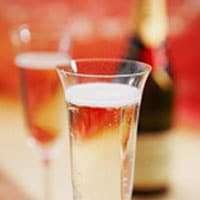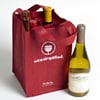 No wine says "Let's celebrate!" quite like Champagne and sparkling wines. They also go beautifully with most foods from appetizers to desserts. And because they're available in a range of prices, you don't always have to wait for a special occasion to pop the cork—remember that next time you order takeout!
No wine says "Let's celebrate!" quite like Champagne and sparkling wines. They also go beautifully with most foods from appetizers to desserts. And because they're available in a range of prices, you don't always have to wait for a special occasion to pop the cork—remember that next time you order takeout!
Technically, anything labeled "Champagne" must hail from the Champagne region of northern France; most all other bubbles are called sparkling wines. Either way, there are plenty of ways to treat yourself, even on a budget and discover new tastes to celebrate.
Flavors and Aromas
Champagnes and sparkling wines range greatly in style. Some will be very dry, with crisp, toasty, and yeasty notes. Others will be fuller with the fruit. Look for citrus, apple, pear, and floral notes in white sparklers; find strawberry, raspberries, and cherry notes in pink-colored sparklers.
The "Brut" Business
Champagnes and sparkling wines are usually labeled with their varying degrees of sweetness. If you like a dry sparkler, look for "brut" on the label; this is the most common dry style. Extra dry or extra sec is dry, but with a little sweetness.
Prominent Plantings

Champagnes from the Champagne region of France are still considered the crème de la crème of sparkling wines, and their prices reflect this. Fortunately, other regions within France and in wine-growing regions throughout the world make fine and affordable Champagne look-alikes. These include Crèmant de Loire from France, sparkling wines from California, and Spain's famous sparkling wine, cava. Even New Zealand sparkling wines are starting to make a splash.
Insider Tip
If you prefer sweeter, lighter, easier-sipping sparkling wines, try Prosecco and the somewhat sweeter Moscato d'Asti, both from Italy.

 You are about to leave publix.com and enter the Instacart site that they operate and control. Publix’s delivery and curbside pickup item prices are higher than item prices in physical store locations. Prices are based on data collected in store and are subject to delays and errors. Fees, tips & taxes may apply. Subject to terms & availability. Publix Liquors orders cannot be combined with grocery delivery. Drink Responsibly. Be 21. For prescription delivery, log in to your pharmacy account by using the Publix Pharmacy app or visiting
You are about to leave publix.com and enter the Instacart site that they operate and control. Publix’s delivery and curbside pickup item prices are higher than item prices in physical store locations. Prices are based on data collected in store and are subject to delays and errors. Fees, tips & taxes may apply. Subject to terms & availability. Publix Liquors orders cannot be combined with grocery delivery. Drink Responsibly. Be 21. For prescription delivery, log in to your pharmacy account by using the Publix Pharmacy app or visiting 
